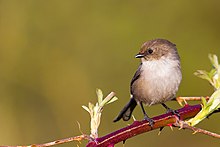| American bushtit | |
|---|---|

| |
| In Chilliwack, British Columbia, Canada | |
| Song of the P. minimus | |
| Scientific classification | |
| Domain: | Eukaryota |
| Kingdom: | Animalia |
| Phylum: | Chordata |
| Class: | Aves |
| Order: | Passeriformes |
| Family: | Aegithalidae |
| Genus: | Psaltriparus Bonaparte, 1850 |
| Species: | P. minimus
|
| Binomial name | |
| Psaltriparus minimus (Townsend, 1837)
| |

| |
The American bushtit, or simply bushtit (Psaltriparus minimus), is a social songbird belonging to the genus Psaltriparus. It is one of the smallest passerines in North America and it is the only species in the family Aegithalidae that is found in United States; the other seven species are found in Eurasia.[2]
The American bushtit's distinguishing characteristics are its petite size, its plump and large head, and its long tail.[3] Its scattered range stretches from highland parts of Mexico and the Western United States to Vancouver, via the Great Basin, the lowlands and foothills of California, southern Mexico, and Guatemala. Bushtits usually inhabits mixed open woodlands, which contains oaks and a scrubby chaparral understory. It can also be found residing in gardens and parks.[citation needed] Their food source is small insects, primarily, spiders in mixed-species feeding flocks.[3]
The sharp-shinned hawk and other birds prey upon American bushtits.[4] Bushtits live in flocks of 10 to 40 birds and family members sleep together in their large, hanging nest during breeding season. Once the offsprings develop wings that are developed enough to fly, they leave the nest and sleep on branches. The Bushtits display a unique behavior as adult males are typically the helpers that assists and raises the nestlings; hence it has intrigued many naturalists for its interesting breeding and mating patterns.[3]
- ^ BirdLife International (2018). "Psaltriparus minimus". IUCN Red List of Threatened Species. 2018: e.T22712028A132100477. doi:10.2305/IUCN.UK.2018-2.RLTS.T22712028A132100477.en. Retrieved 12 November 2021.
- ^ Cite error: The named reference
Townsend-1837was invoked but never defined (see the help page). - ^ a b c "Bushtit Identification, All About Birds, Cornell Lab of Ornithology". www.allaboutbirds.org. Retrieved 2023-10-22.
- ^ "Bushtit". www.oiseaux-birds.com. Retrieved 2023-10-22.
